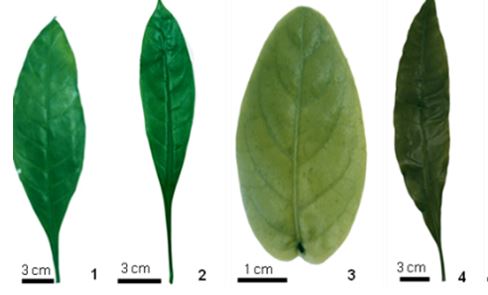Relevance of leaf morphology and biometrics: a study with species of Aphelandra R. Br. (Acanthaceae)
DOI:
https://doi.org/10.20873/jbb.uft.cemaf.v9n4.zotteleKeywords:
blade, leaf structure, variegationAbstract
Morphological characteristics, as well as biometrics, govern the description of species. However, systematical comparative analyzes of these aspects between taxa are scarce. The aim of the work was to evaluate the relevance of these characteristics in species of Aphelandra. Leaves of A. longiflora, A. harleyi, A. espirito-santensis, A. nitida, A. sinclairiana and A. squarosa were collected and analyzed for morphologic patterns: phyllotaxis, texture, leaf blade form, symmetry, apex, base, margin, venation and coloring pattern; and for biometric parameters: total length, length and width of the leaf blade, length and diameter of the petiole. We calculated mean and standard deviations. Among the relevant morphological patterns are the shape of the blade, apex and base, and the biometric data showed differences. As conclusion, this analysis proposal proves to be an instrument of accuracy and detail for descriptions.
References
Aoyama EM, Indriunas A. Morfoanatomia foliar de três es-pécies de Justicia L. (Acanthaceae). Enciclopédia Biosfera, v.9, p.2833-2844, 2013.
Aoyama EM, Indriunas A, Vitoria EL, Monteiro MM. Carac-terização morfológica de frutos e sementes maduros de Jus-ticia scheidweileri V.A.W. Graham (Acanthaceae). Natureza On Line, v.13, p.134-140, 2015.
Azevedo IHF, Braz DM. Seed morphology of Ruellia L. (Acanthaceae) from the southeastern Brazilian Atlantic rain for-est: Taxonomic, phylogenetic, and ecological. Flora, v.240, p.48-57, 2018. https://doi.org/10.1016/j.flora.2017.12.011
Azevedo IHF, Moraes P. Seed morphology of ruellieae Spe-cies (Acanthaceae) in Brazil and Its Taxonomic Implications. Systematic Botany, v.44, n.3, p.631-651, 2019. https://doi.org/10.1600/036364419X15620113920662
Bell AD, Bryan A. Plant form: an illustrated guide to flower-ing plant morphology. London:Timber Press, 2008.
Ellis B, Daly DC, Hickey LJ, Johnson KR, Mitchell JD, Wilf P, Wing SL. Manual of Leaf Architecture. New York: Itha-ca, 2009.
Hickey LJ. Classification of the architecture of dicotyledonous Leaves. American Journal of Botany, v.1, p.17-33, 1973.
Indriunas A, Aoyama EM. Microescultura da testa da semente madura de Ruellia elegans Poir. (Acanthaceae). Journal of biotechnology and biodiversity, v.8, n.4, p.349–352, 2020. https://doi.org/10.20873/jbb.uft.cemaf.v8n4.indriunas
Jesus GS, Indriunas A, Aoyama EM. Caracterização mor-fológica de Megaskepasma erythrochlamys Lindau (Acan-thaceae). 2020. 40, Encontro Regional de Botânicos MG, BA e ES. Anais... Vitória, ES.
Martin RE, Asner GP, Bentley LP, Shenkin A, Salinas N, Huaypar KQ, Pillco MM, Delis F, Álvarez C, Enquist BJ, Diaz S, Malhi Y. Covariance of sun and shade leaf traits along a Tropical Forest Elevation Gradient. Frontiers in Plant Science, v.10, p.1-13, 2020. https://doi.org/10.3389/fpls.2019.01810
Monteiro MM, Indriunas A, Aoyama EM. Morphological characterization of fruits and seeds of Ruellia furcata (Nees) Lindau (Acanthaceae) from Espírito Santo State, Brazil. Multi-Science Journal, v.3, n.3, p.65-68, 2020. https://doi.org/10.33837/msj.v3i3.1265
Profice SR. Espécies de Aphelandra R.Br. (Acanthaceae) no estado do Rio de Janeiro - Morfologia foliar e das brácteas. Rodriguésia, v.42, p.51-65, 1990/92.
Profice SR, Andreata RHP. Revisão taxonômica de Aphelan-dra R. Br. (Acanthaceae) de corola curto-bilabiada. Instituto Anchietano Pesquisa, v.62, p.7-70, 2011.
Profice SR, Wasshausen DC. Aphelandra espirito-santensis (Acanthaceae), a new species from Espírito Santo, Brazil. Novon, v.3, p.280-283, 1993.
Stuessy TF. Plant taxonomy: the systematic evaluation of comparative data. New York: Columbia University Press, 2009.
Wasshausen DC. The genus Aphelandra (Acanthaceae). Smithsonian Contributions to Botany, v.18, p.1-157, 1974.

Downloads
Published
How to Cite
Issue
Section
License
Copyright (c) 2024 - Journal of Biotechnology and Biodiversity

This work is licensed under a Creative Commons Attribution 4.0 International License.
Authors who publish with this journal agree to the following terms:
Authors retain copyright and grant the journal right of first publication with the work simultaneously licensed under a Creative Commons Attribution License (CC BY 4.0 at http://creativecommons.org/licenses/by/4.0/) that allows others to share the work with an acknowledgement of the work's authorship and initial publication in this journal.
Authors are able to enter into separate, additional contractual arrangements for the non-exclusive distribution of the journal's published version of the work (e.g., post it to an institutional repository or publish it in a book), with an acknowledgement of its initial publication in this journal.
Authors are permitted and encouraged to post their work online (e.g. in institutional repositories or on their website) prior to and during the submission process, as it can lead to productive exchanges, as well as earlier and greater citation of published work (Available at The Effect of Open Access, at http://opcit.eprints.org/oacitation-biblio.html).


